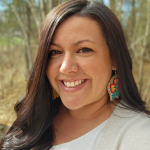THUNDER BAY – Jasmine Sgambelluri had to keep a secret for a little over a month.
The First Nations, Métis and Inuit education resource teacher for the Lakehead District School Board found out in early May that she would be getting the Prime Minister’s Award for teaching excellence.
However, she couldn’t let everyone know that she would be receiving the national certificate of excellence until the official announcement was made on June 12.
“I could share the news with my close family and my nominators, but other than them, I had to keep everything on the down low with everyone else,” Sgambelluri said.
“I was actually caught quite off-guard and a little bit shocked when I found out that I was one of the 17 national recipients. When you get that initial phone call, it’s like a bit of an out-of-body experience.”
After taking everything in following the phone call, Sgambelluri was thankful for everyone who had helped her along the way.
“I couldn’t do this work alone,” Sgambelluri said. “There’s a shared commitment to making a positive difference in the lives of students and families from everyone within the school board.
“This is very much a collaborative effort as I’m included by the people I get to work with every day, my family and my educators along my learning journey."
In her role, Sgambelluri works with teachers from kindergarten to Grade 8 in creating and embedding Indigenous perspectives and helping them connect with the community.
That role sees her working with community Elders, knowledge carriers, artisans, Indigenous people and Indigenous organizations locally to create resources that she brings into classrooms and schools to help educators bring authentic Indigenous voices and perspectives into their learning spaces.
Sgambelluri has also found herself leading learning opportunities for students, such as during Treaties Recognition Week in November where Grade 5 students were brought to do some learning with her on the Canadian Geographic Indigenous People’s floor map and by looking at more localized matters such as the Robinson-Superior Treaty.
“Working as part of our Indigenous educational team, I’ve gotten to see an incredible change over the last six years,” Sgambelluri said. “There’s a growth in knowledge for our educators and our students, and that knowledge is being spread into the fabric of our community.
“The parents of the students are part of this learning too. These are things that weren’t taught when we went to school, so we’re actually positioning ourselves as learners alongside the students and allowing the voices of Indigenous people to be the guide and to be the ones that are sharing the knowledge.”
Looking at the future, Sgambelluri said the school board’s Miiniwewinan: Indigenous Education Advisory Committee will play a key part in what’s next for students and the lessons they learn.
The committee is made up of community Elders and knowledge carriers, educators, Indigenous parents, an Indigenous trustee, an Indigenous student trustee, the school board’s superintendent and community partners.
“We talk about what their hopes and dreams are for what they want to see in our schools and what they hope that our students will be learning,” Sgambelluri said.
“They are the ones that guide those next steps. We gather their voices, along with others, and then we kind of put together a plan of where we would like to go next.”



